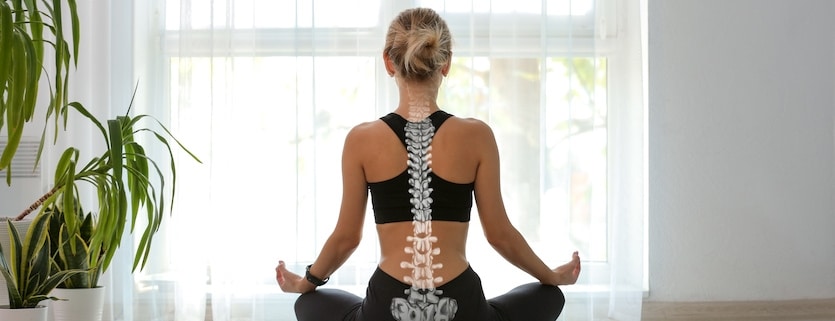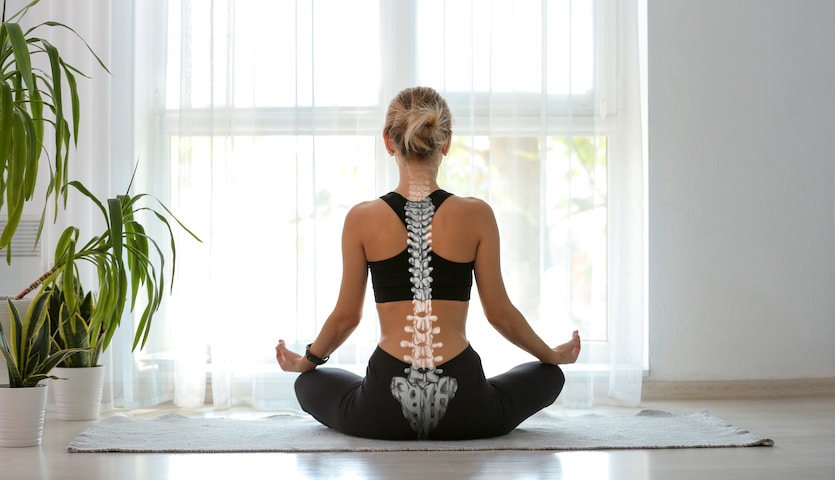Head Up, Shoulders Back—How to Maintain Good Posture
Body language is a powerful communicator. Your posture, the way you hold your body, exudes confidence. It can show others if you are listening to them or even express if you’re feeling shy, tired, and so much more.
And, as it turns out, it can also affect your health.
The ties between posture and health cut both ways. Good posture brings great benefits, and, on the flip side, bad posture can be detrimental to your health. Let’s take a look at each element of your posture: the good, the bad, and what you can do about it.
Posture Perfect
Before getting into the nitty gritty, what exactly is posture and what makes it good or bad? “Good” posture is typically easy on your body: carrying yourself in positions that don’t strain or tweak your muscles and joints. “Bad” posture, well, does the opposite. (More on that later!)
Posture can be broken into two categories: static (not moving) and dynamic (in motion). For now, we’ll deep dive into static posture. When your body is at rest, you’re probably doing one of three things: sitting, standing, or lying down. Let’s take a look at the ideal posture for each:
- Sitting: You’ve probably heard it a thousand times: “sit up straight!” This is by no means bad advice, but it focuses solely on the spine. And good sitting posture is a whole-body activity. When sitting, strive to keep your back straight and balanced above your hips. Your shoulders should be relaxed, and your feet should rest flat on the floor. If you work at a computer desk, position your monitor so you are looking straight ahead, not slightly down. This helps reduce the tension exerted on your spine. Overall, good sitting posture should feel relatively neutral: if something seems tense or strained, it may be a sign to reevaluate your sitting position.
- Standing: As with sitting, good standing posture starts with the spine. To maintain an ideal standing body position, focus to keep your back straight up and down—not rigidly, but in a natural, relaxed stance. Your shoulders shouldn’t be hunched forward, but pulled back so they are balanced over your hips. Engage your abdominal muscles to help maintain this position. Your feet should be about shoulder-width apart, with your weight balanced on the balls of your feet. Once again, try to avoid angling your head in strange directions: looking straight ahead causes the least spinal strain.
- Lying down: People can get surprisingly opinionated about sleep positions. But whether you’re a back-, side-, or belly-sleeper, one thing is true: you should try to keep your ears, shoulders, and hips in alignment. By maintaining this axis through your body, you reduce strain on your neck and spine—which, in turn, can help reduce pain in your day-to-day. Sometimes this means getting creative with your pillow placement. If you sleep on your back, a pillow under your knees can help maintain the body’s natural contours. And for the side sleepers out there, a pillow placed between the knees has a similar effect. Belly-sleepers should use a flat pillow for their head (or no pillow at all). An additional pillow under the pelvis can also help reduce stress on the spine.
Why Bother: The Benefits of Good Posture
As a general rule, a little pain and discomfort each day is inevitable. It’s just part of life. That being said, there are steps you can take to help reduce the amount of discomfort you experience each day—and one is paying attention to your posture. Good posture can have a positive impact on your health by:
- Reducing back pain: Sitting off-kilter or hunched over can increase the strain on your lumbar spine (aka your lower back). With time, this strain can lead to back pain. Good sitting and standing postures help you avoid this unnecessary discomfort by keeping lower back strain to a minimum.
- Easing neck and shoulder tension: Proper posture balances your head comfortably over your spine. This reduces the amount of weight your head and shoulders have to support, which in turn reduces muscle tension in those areas.
- Decreasing frequency of headaches: One of the most common culprits behind headaches is tension. And as mentioned, good posture can reduce the amount of tension in your neck and shoulders. While this may not eliminate all the headaches you experience, it will certainly help keep them at bay.
- Increasing energy levels: Good posture is all about keeping your body balanced and neutral. In other words, it’s about not creating extra work for your stabilizing muscles. (You know what they say: work smarter, not harder.) This can reduce fatigue and muscle strain, giving you more energy throughout the day.
- Improving joint health: Your body’s joints naturally experience wear-and-tear throughout your life. After all, they do move a lot. Some movements—especially unnatural ones—wear your joints down more than others. Proper posture can help you avoid many of these unnatural movements, keeping your joints healthier for longer.
- Expanding lung capacity: Your lungs are the center of your respiratory system—needless to say, they’re pretty important. And to do their job properly, your lungs need room to expand fully. Slouching can restrict the amount of space they have, making it harder to breathe.
How Bad Posture Affects Your Health
Posture goes way beyond the way you look. Poor posture can directly impact your physical health. Some of the most common effects of bad posture include:
- Neck, shoulder, and back pain: Posture is all about alignment. When your body—especially your neck and back—are out of alignment, it can cause unnecessary strain on your muscles and joints. Over time, this can lead to tension and pain.
- Increase risk of spine injury: Slouching gradually wears down your spine and other joints. This might not seem like a big deal, but years of bad posture can catch up to you. The weaker your spine, the more fragile and prone it is to injury.
- Decreased flexibility: Pulling your shoulders forward, slouching, and other forms of bad posture can all reduce your range of motion over time. When your muscles get accustomed to unusual or unnatural positions it can be difficult to return to a neutral stance. In other words, your abdomen, back, and shoulders can lose flexibility, making it more difficult to practice good posture.
- Poor digestion: Like your lungs, your organs need space to do their jobs—space that’s naturally provided in your abdominal cavity. When you hunch forward or slouch, it can reduce this space, making it harder for your body to process and digest food.
- Headaches: Tension in your neck and shoulders is one of the most common effects of bad posture. It’s also one of the most common causes for headaches. So next time you feel your posture slipping, remember: you’re setting yourself up, literally and figuratively, for future headaches.
How to Improve Your Posture
No matter where you are in your posture journey, the tips and tricks below can help you ditch the slouching and keep your posture balanced and natural:
- Stay active: Good posture is all about holding your body in the right way. And this takes strength—not a lot of it, but enough to keep your body stable and upright. An active lifestyle can help keep your muscles strong enough to maintain good posture throughout the day.
- Stretch regularly: If you’ve found that sitting up straight feels uncomfortable, this might be due to a lack of flexibility. It’s important to keep your body limber and flexible, which requires regular stretching. When it comes to posture, focus on stretching your neck, shoulder, and back muscles.
- Keep your abs strong: As mentioned, strength is a big part of posture—specifically core strength. Your abs and core muscles help keep your torso upright and balanced, making good posture possible. There’s no right way to exercise these muscles—try anything from abdominal crunches and other ab exercises to swimming, yoga, and more.
- Practice curve reversal: If you’ve been hunched forward for an extended time, counteract and “reset” your posture by stretching the other direction. Known as curve reversal, this is a great way to stretch or to simply remind yourself to return your posture to a more neutral position.
- Avoid squishy chairs: Who doesn’t love a nice, plush chair? But like most good things, squishy chairs are best in moderation. If you’re going to be sitting for an extended period of time, it’s best to choose a firm seat with good back support to help you maintain proper posture as you sit. Soft chairs with lots of give let you to sink into the cushions, so keeping your body upright takes much more work.
- Lift with your legs, not your back: It’s difficult to maintain good posture with a weak or injured back—so be careful! When lifting heavy objects, try to keep your back straight. Instead of bending over to lift, bend your knees and use your quads to raise yourself back up.
- Be mindful: It may seem simple, but one of the most important aspects of posture is simply being mindful of how your body is positioned. If you notice yourself slouching or hunching forward, take a moment to readjust your posture.
- Adjust work surface height: If you have a desk job, sitting up straight is only half the battle. You should also make sure your work surface is right height for good neck posture. Try to position your monitor so you are looking straight ahead. If your desk is too low, you may naturally hunch forward to reach it. Or if it is too high, your feet may not rest comfortably om the floor. If this is the case, adjust your desk so your arms reach it comfortably and your feet are flat as you sit up straight.
As you go throughout your busy day, try to be mindful of your posture. Over time, it’ll become more and more natural to keep your body upright, neutral and in alignment. Good posture will benefit your health and you might even feel a boost in confidence.
References
https://www.health.harvard.edu/staying-healthy/why-good-posture-matters
https://medlineplus.gov/guidetogoodposture.html
https://www.healthline.com/health/fitness-exercise/posture-benefits
https://www.betterhealth.vic.gov.au/health/conditionsandtreatments/posture
https://newsinhealth.nih.gov/2017/08/getting-it-straight
https://www.mayoclinic.org/healthy-lifestyle/adult-health/multimedia/back-pain/sls-20076817
https://health.clevelandclinic.org/health-effects-of-poor-posture/
https://www.hopkinsmedicine.org/health/wellness-and-prevention/choosing-the-best-sleep-position
https://www.urmc.rochester.edu/encyclopedia/content.aspx?ContentTypeID=1&ContentID=4460













